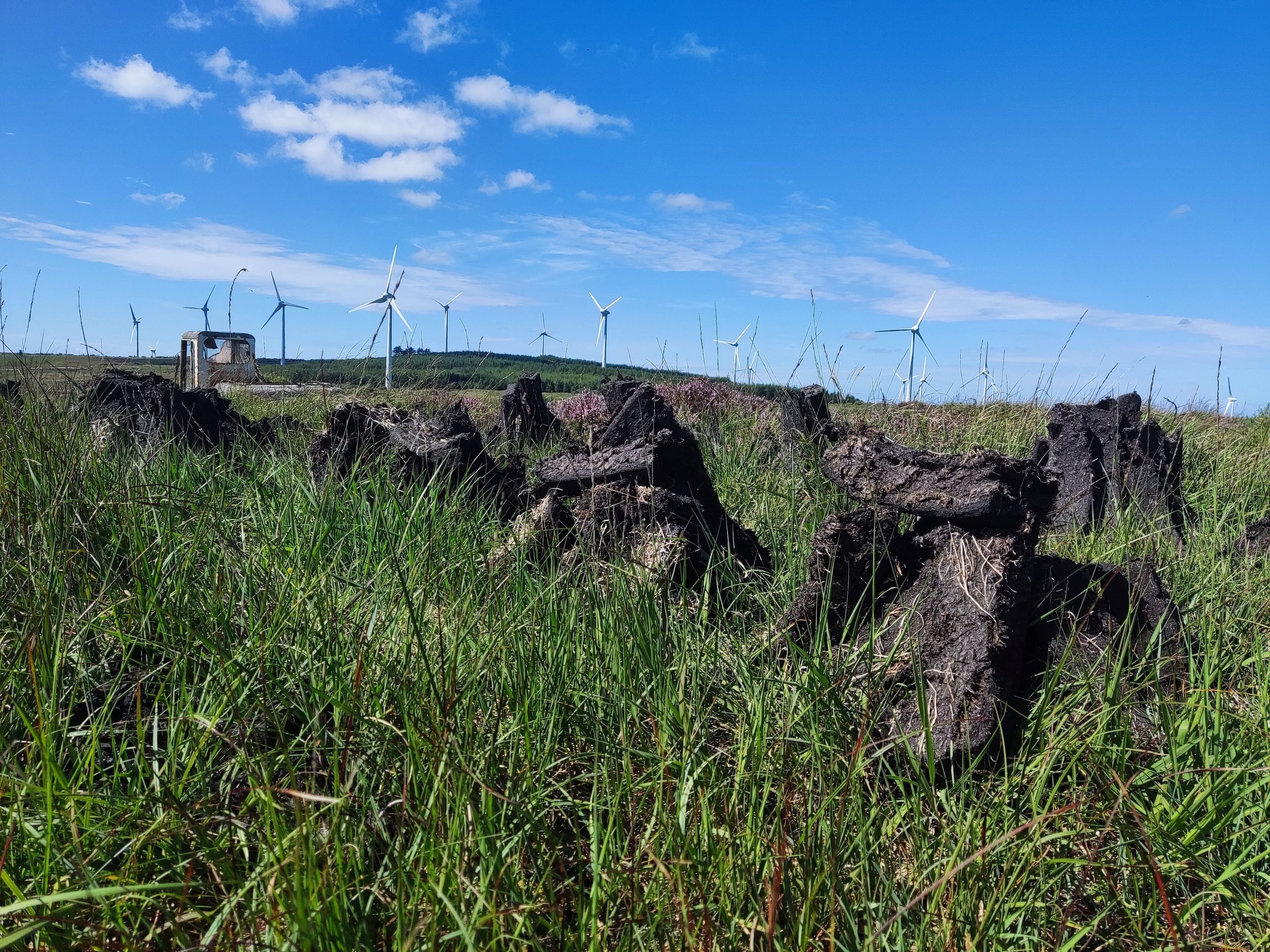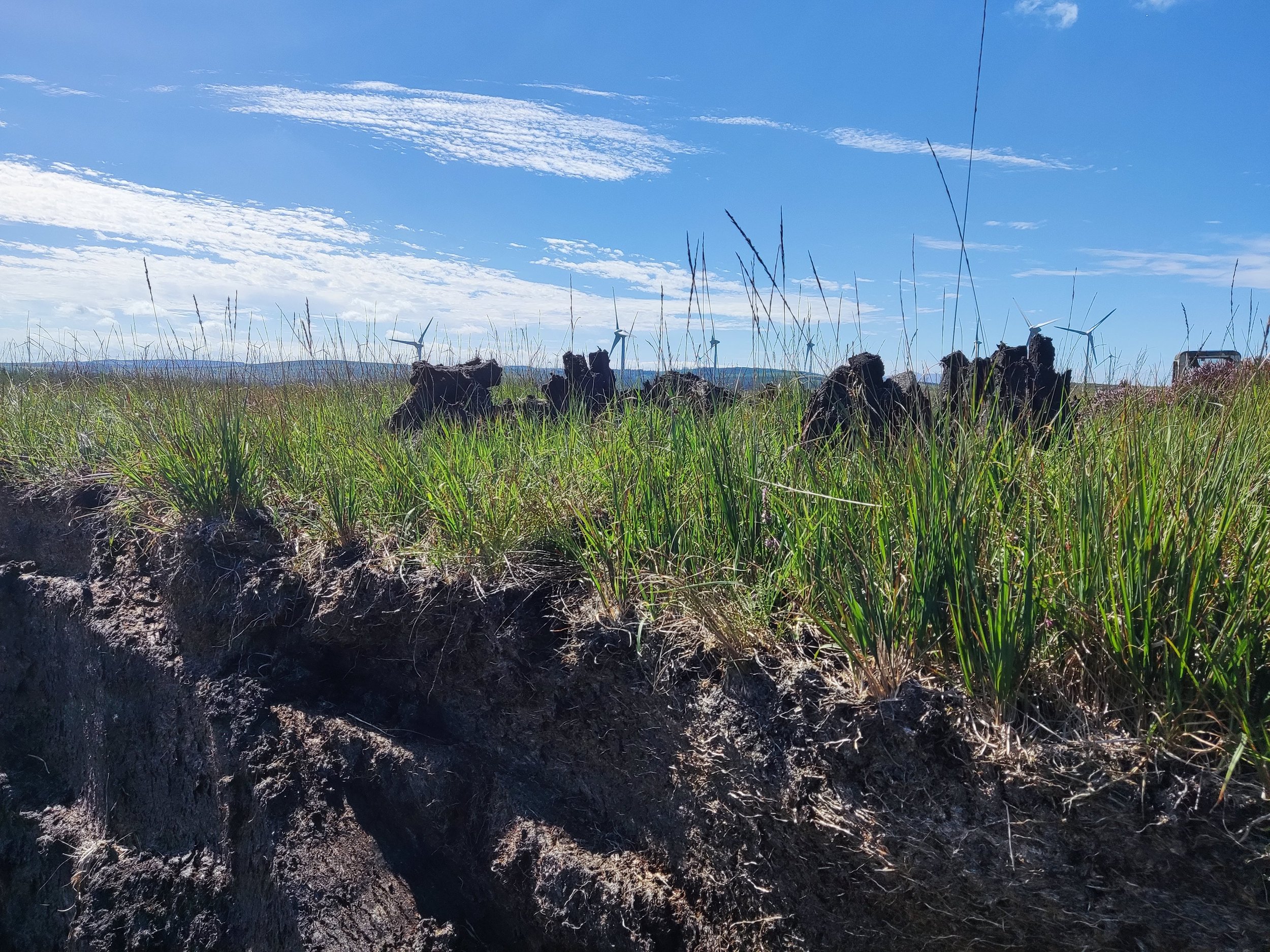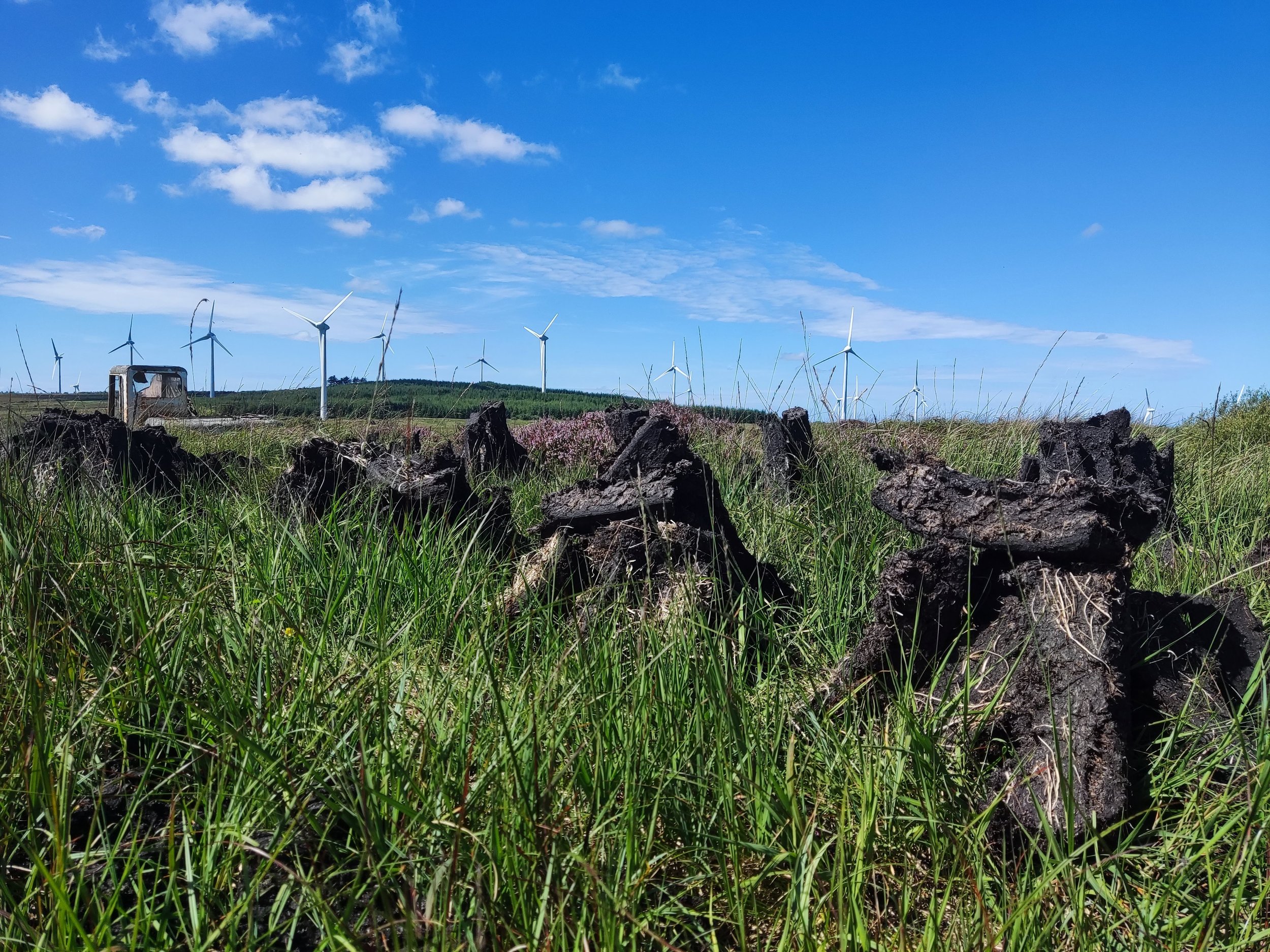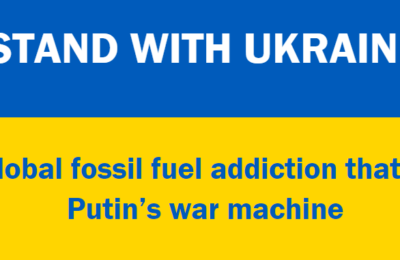A major project is underway to preserve and renew boglands in Ireland.
This article from the Irish Times is very useful and we reproduce below another article from Rupture-the Irish Ecosocialist magazine.
There is also a similar project in Wales.
Saving Ireland’s ‘coral reef’
by Patrick Flynn
Every summer I can recall, from my earliest memories of my childhood to the time my father and uncle became too old for rigorous labour and began to buy their fuel instead, was marked by visits to the bog. Historically, many smaller farmers and sections of the working class across Ireland were forced to rely on burning turf for want of better alternatives, and some households, my father and uncle among them, still use turf as a cheap source of heating, chiefly concentrated in western and midlands counties.
The turbary rights for this bogland, on the outskirts of my hometown in this corner of east Galway, had been in our family for generations – indeed, it is still owned by the English descendants of the Anglo-Irish family who dominated the town under British rule, though they show little interest in its upkeep. The ritual for saving the turf remained much the same as it always had. After the turf was cut, each sod of turf would be turned so the sun could assist in drying it. The sods were then ‘footed’, with five or six at a time placed upright, leaning against each other for further drying. We would then wheel it a short distance away and build a ‘clamp’, a large mound of turf built to allow the sods to air-dry further over a period of months, before the sods were ready to be brought back to our shed at home, where they would give us a ready supply of fuel for the coming year. It was a long process, punctuated by plenty of midge bites and well-earned breaks to pass around the bottle of flat 7-Up stashed nearby, but one which promised a reliable and secure yearly supply of fuel when the turf was finally home.
“The romantic image of the turf-cutter using the sleán is iconic in Irish culture.”
But much had also changed in the turf-cutting process between my father’s childhood and my own. Throughout Ireland, turf was once cut with the sleán, a spade with an iron flat-bladed head. The romantic image of the turf-cutter using the sleán is iconic in Irish culture. In one of my favourite poems, Seamus Heaney evocatively compares his own craftsmanship as a poet with the craftsmanship of how his grandfather cut turf by ‘Nicking and slicing neatly, heaving sods/Over his shoulder, going down and down/ For the good turf. Digging.’[1] But by the late twentieth century, this form of turf-cutting, the least invasive on the bog as a habitat, had been driven to near extinction, and it now only persists in isolated pockets of the country. Socialist analyses of turf-cutting which oppose restrictions on the commercial sale of turf because cutting by sleán is less invasive than mechanised cutting simply ignore how negligible the use of the sleán is now.[2]

Instead, from the 1980s, turf-cutters, including small-scale ones like my family, began to hire contractors who owned tractor-driven machinery to cut their turf for them. These machines consist of two types, the first of which is the sausage machine. This resembles a large chainsaw attached to the back of the tractor, with a blade which cuts into the bog itself and pipes peat through an outlet that creates multiple strands of turf. Reminiscent of the production of sausages, this process gives the machine its eponymous nickname. The sausage machine has been an environmental disaster: it cuts numerous drains across the bogs’ surface, ruining its ability to retain water, and already by my childhood, large trenches caused by its use were visible across the bog where we cut. The second machine is the hopper, memorably described by scholar Martin McHugh as ‘a glorified “Play-Dou” machine that is filled with turf by a digger’, which then, ‘like the sausage machine, squeezes turf into lines’. Unlike the sausage machine, it can transport the turf to be spread in a dryer area. While McHugh argues that the hopper is less invasive than the sausage machine, as unlike the sausage machine it can spread turf anywhere, creating localised holes that are ‘repairable’ if needed, he emphasises that its impact is still disastrous: ‘You can never fully repair a bog as it will take thousands of years to re-form. All you can do is patch it up and let nature take over’. [3]
The environmental consequences
“Centuries of human use of peatlands have caused the loss of over 70% of Ireland’s bogs.”
It is hard to overstate the environmental damage these machines have done to our bogs, as the loss of peatlands caused by peat harvesting has been an unmitigated environmental and biodiversity disaster. Centuries of human use of peatlands have caused the loss of over 70% of Ireland’s bogs; this has alarmingly accelerated in recent decades as the use of the sleán has been almost driven to extinction by the emergence of hopper and sausage machines.[4] This is particularly devastating as Ireland’s bogs are the richest in Europe, and are among the best natural resources we have. Bogs are excellent carbon sinks; known peatlands cover about 3% of the world’s land surface, but store 40% of the world’s soil carbon, at least twice as much carbon as all of Earth’s standing forests. Globally, peatlands lock in up to 1,000 billion tonnes of carbon – twice as much as forests.[5]

Peat soils cover 20% of Ireland’s land mass yet contain 75% of all our soil organic carbon, storing over one billion tonnes of carbon, while near-intact Irish peatlands are estimated to actively capture around 57,000 tonnes of carbon per year. Mechanically harvesting peat, for fuel or horticulture, involves digging channels to drain moisture from the bog, which, in releasing carbon, turns these vital carbon sinks into sources of carbon. Turf itself is the worst of all fuel sources with respect to its greenhouse gas emissions and impact on climate, as it has higher carbon dioxide emissions per unit of energy than any other fossil fuel source, including coal and gas.[6] The destruction of these important habitats for burning turf is akin to chopping down the Amazon to burn the wood.
Like the Amazon too, bogs are treasure troves of biodiversity, and their decline is contributing to the biodiversity as well as the climate crisis. The water-logged conditions in bogs are home to lots of species, including rare birds, plants and insects, whose survival in these diverse ecosystems are currently at risk due to habitat loss. Carrownagappul bog, which lies just outside Mountbellew in east Galway, is one example of the importance of bog restoration for biodiversity. With more than 100 turf-cutting families compensated or relocated elsewhere, its restoration began in earnest in 2012, as drains created by mechanised turf-cutting were blocked with peat and plastic dams to raise water levels in the bogs, encouraging the growth of sphagnum mosses, peat’s main ingredient. The visible recovery of the Carrownagappul bog in recent years has contributed to the conservation of the flora and fauna which call it home, including 25 varieties of moss as well as numerous insect-eating plants and lichen; it is not for nothing that Ronan Casey of the Living Bog Project refers to it as “Ireland’s coral reef”. During the Covid restrictions, many locals also began to re-explore this remarkable landscape on their doorstep while exercising near their homes. Ending turf-cutting on the bog has not severed the local community from it – rather, as the bog has begun to recover and thrive, it has deepened their connection to it.[7]
Government representatives now praise the achievements at Carrownagappul, including some who opposed the ban on harvesting peat on the bog in the first place.[8] But rare success stories do not obscure the disastrous loss of our raised bog network under successive governments, and too little has been done to protect and restore them. The statistics are damning. Over 37% of our active raised bog network has been lost in the past two decades, and just 1% of Ireland’s active raised bogs now remain after years of land reclamation and turf-cutting. Peat was extracted from over 280 plots on protected active raised bog sites last year, contributing to their further deterioration. Despite the designation of raised bog sites as protected areas between 1997 and 2003, it took the state between 15 and 23 years to set site-specific conservation objectives for over 260 of Ireland’s protected sites. It was not until 2017, in response to an ongoing infringement action against Ireland for failure to fully protect bogs in line with requirements under the Habitats Directive, that a national management plan was launched setting out how they should be managed, conserved and restored. All the while, this tardiness has contributed to the further decline of our bogs.[9]
The ecosocialist response
Irish socialists, being concentrated and much better organised in urban rather than rural Ireland, had little direct involvement in the campaigns against the banning of cutting peat on Ireland’s active raised bog network in 2011. Insofar as the United Left Alliance (ULA) and its component organisations commented on the issue, they defended turf-cutters, such as those at Clonmoylan bog in east Galway, as examples of poorer rural communities resisting attacks on living standards imposed by the European Commission, and argued that it was hypocritical for the Irish state to restrict turf-cutting for local communities while allowing private companies to exploit Ireland’s offshore oil and gas, or Bord na Móna to cut turf on an industrial scale.[10] And these points were not incorrect, in and of themselves – however, crucially, the environmental costs of turf-cutting were sidestepped, and given nowhere near the attention it merited. I remember my surprise when one ULA member in Galway argued that the branch should stand with turf-cutters in areas like Clonmoylan in their campaigns to continue cutting turf, to which I replied to point out the disastrous consequences of turf-cutting for climate and biodiversity. Due to the diligent work of ecosocialists in the years since, the socialist left in Ireland has a much better understanding of these questions today.

As ecosocialists, we cannot minimise or evade the central question of the damage turf-cutting has done and is doing to our environment. It is crucial that we fight for an unconditional end to the commercialised sale of peat alongside a genuine just transition for all those reliant on turf-cutting. People Before Profit has played an important role in this in recent years, arguing that semi-state company Bord na Móna should end involvement in turf-cutting while demanding that its 2,400 employees across the midlands be transitioned to renewable jobs in peatland restoration, home retrofitting, and other secure climate jobs, rather than be shunted into precarious employment. Bríd Smith has been particularly vocal in condemning the paltry 6 million euro just transition fund allocated by the government to Bord na Móna workers, and the company’s consistent refusal to engage with unions at the Workplace Relations Commission on the generation of secure alternative jobs, proper redundancy programme and pension provisions and support for midlands communities impacted.[11]
PBP’s support for Bord na Móna workers in their fight for a just transition is an important example of how ecosocialists should intervene in struggles around turf-cutting. While it undoubtedly remains a predominantly urban-based party, recent developments such as the formation of the PBP rural caucus have increased the party’s focus on rural issues, including discussion on the importance of protecting and restoring our bogs alongside demanding a just transition for communities reliant on burning turf. PBP members and Irish ecosocialists more broadly should continue to get involved in local campaigns to save our peatlands from destruction, such as the Save Ardee Bog campaign which PBP comrades in Louth are already involved in.
How socialists should respond to turf-cutting and questions of just transition is a matter of ongoing discussion in the movement. At the PBP AGM last May, there was a lively debate on how to respond to the proposals for a ban on commercial turf extraction. A motion proposed by my own branch in Galway, which received wide support, committed the party to support a ban on the commodified distribution of turf for profit as a step towards ending the commercial stripping of our bogs. It also pledged PBP to support a genuine ecosocialist just transition for those with turbary rights and households which burn turf as their chief fuel source, demanding they receive immediate funding for retrofitting and renewable electric heat, as well as the rolling out of an ecosocialist green rural jobs programme for affected rural communities.
“Would we make our demand for an end to logging in the Amazon conditional on support for workers reliant on the industry
being in place?”
However, disagreement emerged during the debate on how to respond in the case of the introduction of a one-sided ban from the government, without necessary just transition measures. An amendment saying that a ban on commercial turf extraction should only be supported if just transition measures were included was supported by most delegates, while a minority of delegates argued that PBP’s support for ending the commodified selling of turf should be unconditional, given its disastrous consequences.[12] While there was neither unanimity within PBP nor RISE on this debate, I myself took the latter view that PBP must be clear about how destructive turf burning is and that we should campaign for full supports, rather than putting ourselves in a position where we would oppose a ban because there aren’t supports. Would we make our demand for an end to logging in the Amazon conditional on support for workers reliant on the industry being in place? People don’t understand how important bogs are, so they don’t see the comparison – but in reality, the situation is no different.
As Brian Ó Cathail has argued in these pages previously, Irish ecosocialists should advocate for unavoidable environmental changes such as a ban on the commercial selling of turf, including where these changes will be in conflict with ‘in many ways justifiable popular sentiments’. This is particularly important for issues such as turf, where socialists did not previously sufficiently address the topic through an ecological lens, undermining their credibility on climate and biodiversity.[13] PBP’s demand for an end to commercialised turf-cutting alongside a just transition for turf-cutters, a stance recently ratified by members, demonstrates principled ecosocialist politics, which is absolutely crucial in the face of climate and biodiversity crisis. While successive right-wing governments continue to abrogate their responsibilities on the matter, the campaign to save our bogs, while ensuring a just transition for the workers and communities reliant on them, will continue to be a central struggle for Irish ecosocialists, as their importance for climate and biodiversity is difficult to overstate.
Endnotes
1. Seamus Heaney, ‘Digging’, Death of a Naturalist (London, 1966), https://www.poetryfoundation.org/poems/47555/digging
2. Indicative of this is the Twitter thread on turf-cutting by Irish Maoist group Anti-Imperialist Action Ireland, 13 April 2022, https://twitter.com/AIAIreland/status/1514298292259205128
3. Martin McHugh, ‘All you need to know about turf-cutting’, RTÉ Brainstorm, 26 April 2022, https://www.rte.ie/brainstorm/2021/0325/1206028-bogs-turf-cutting-culture-climate-change-ireland/
4. Mark Hilliard, ‘Turf-cutting contributing to shocking deterioration of midlands – report’, Irish Times, 8 July 2022, https://www.irishtimes.com/news/environment/turf-cutting-contributing-to-shocking-degradation-of-peatlands-report-1.4299316
5. Virginia Gewin, ‘How peat could protect the planet’, Nature, 12 February 2020, https://www.nature.com/articles/d41586-020-00355-3
6. Irish Peat Conservation Council, ‘Climate Change and Irish peatlands’, https://www.ipcc.ie/a-to-z-peatlands/irelands-peatland-conservation-action-plan/peatland-action-plan/climate-change-and-irish-peatlands/, accessed 18 August 2022.
7. Rodney Farry, ‘Galway turf cutters turn environmental protectors in big to preserve bogs’, Irish Times, 18 January 2021, https://www.irishtimes.com/news/environment/galway-turf-cutters-turn-environmental-protectors-in-bid-to-preserve-bogs-1.4460627
8. Ibid.
9. Niall Sargent, ‘Peat was cut at 280 plots in protected bogs last year without State consent’, thejournal.ie, 13 January, 2022, https://www.thejournal.ie/peats-sake-pt3-sac-plots-5650149-Jan2022/
10. Socialist Worker (Ireland), July 2012.
11. People Before Profit, ‘Government’s total disregard for Bord na Móna workers,’ 12 November 2019, https://www.pbp.ie/no-justice-for-workers-in-the-governments-just-transition/
12. Cian Prendiville, ‘PBP AGM 2022: Building an ecosocialist party of struggle’, Rupture, 20 June 2022, https://rupture.ie/articles/building-ecosocialist-party
13. Brian Ó Cathail, ‘We need to be consistent’, Rupture, issue 7, 19 June 2022, https://rupture.ie/articles/we-need-to-be-consistent


